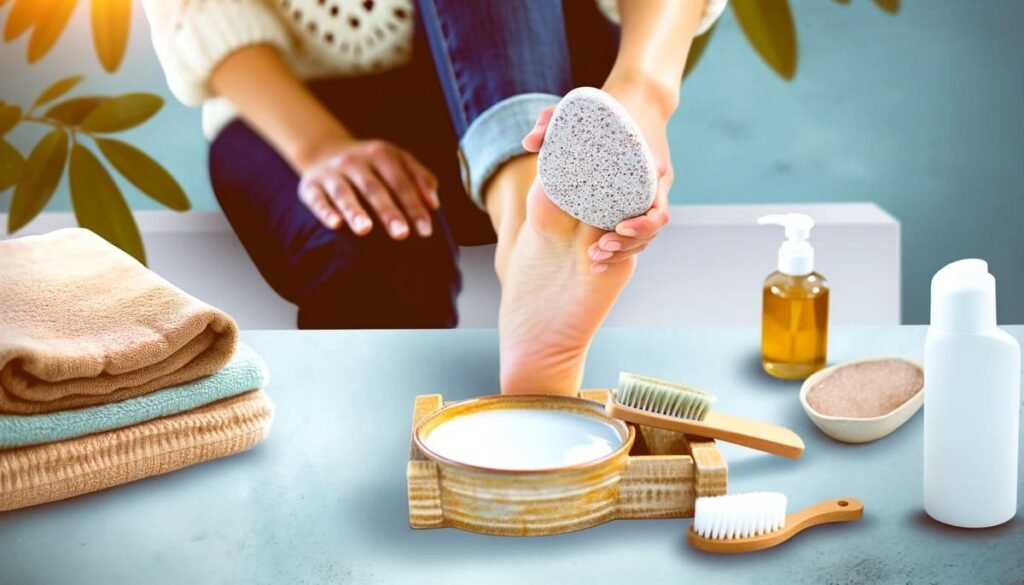
Hard skin on the feet, also known as calluses, can be an uncomfortable and unsightly issue. These thickened areas of skin often form as a result of friction or pressure, typically developing on the heels, balls of the feet, or sides of the toes. Not only can they make walking painful, but they can also make your feet look less appealing. Fortunately, there are various methods to safely remove hard skin and prevent its recurrence. This comprehensive guide will explore effective ways to manage and eliminate hard skin on your feet, ensuring they remain healthy and soft.
Contents
Understanding Hard Skin on Feet
Hard skin or calluses are protective responses of your skin to repeated friction or pressure. They are most common among individuals who frequently wear ill-fitting shoes, stand for prolonged periods, or have foot deformities. While calluses are generally not harmful, if not managed properly, they can lead to discomfort and other foot problems.
Preventive Measures
- Choose the Right Footwear: Wear shoes that fit well and provide adequate cushioning and support. Avoid high heels and shoes with narrow toe boxes that can increase pressure on specific parts of your feet.
- Use Protective Paddings: Using non-medicated pads around areas that tend to form calluses can help reduce pressure and friction.
- Keep Feet Moisturized: Regularly apply a good foot cream to keep the skin on your feet soft and reduce the buildup of hard skin.
- Maintain Proper Foot Hygiene: Wash your feet daily with soap and water, and thoroughly dry them, especially between the toes, to prevent skin hardening from moisture.
Effective Treatments for Hard Skin
- Soaking and Exfoliation: Soak your feet in warm water for about 10-15 minutes to soften the hard skin. After soaking, use a pumice stone or foot file to gently rub the thickened skin areas. Be cautious not to remove too much skin, as this can lead to bleeding or infection.
- Over-the-Counter Remedies: There are various creams and ointments available that contain ingredients like salicylic acid, urea, or lactic acid that can help soften calluses. Apply these as directed on the packaging.
- Professional Care: If your calluses are painful or very thick, it may be wise to seek help from a podiatrist. Professionals can safely trim excess skin and may prescribe orthotic devices to correct foot mechanics.
Home Remedies
- Apple Cider Vinegar: Soak a cotton ball in apple cider vinegar and tape it to the hard-skin area overnight. The acidity helps soften the skin for easier removal.
- Baking Soda Paste: Mix baking soda with a small amount of water to make a paste and apply it to the affected area to gently exfoliate the skin.
- Olive Oil or Coconut Oil: Regular application of these oils can keep the skin soft and prevent hard skin formation.
FAQs
Q: How often should I exfoliate the hard skin on my feet?
A: Once a week is typically sufficient to maintain soft skin without causing irritation or damage.
Q: Can hard skin on feet lead to more serious problems?
A: Yes, if left untreated, hard skin can crack, leading to infections. It’s important to manage it properly.
Q: Are there any specific exercises I can do to prevent calluses?
A: Yes, foot exercises and stretches can improve foot strength and flexibility, reducing the risk of calluses due to abnormal walking patterns.
Conclusion
Dealing with hard skin on your feet can be a tedious but manageable task. By incorporating preventive measures, utilizing effective treatments, and applying home remedies, you can maintain healthy, soft feet free from uncomfortable calluses. Regular care and attention to your foot health are key to avoiding future problems.